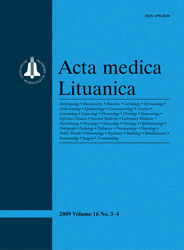 ISSN 1392-0138 ISSN 2029-4174 (online) |
2008 m. Nr. 1 Bivariate body height-weight classification – a useful tool in systematization and analysis of medical data
Background. An anthropometric whole body model used in different Estonian studies of Kaarma and her co-workers since 1995 has proved to work in assessment of physical peculiarities of the body and its structure regularities in different age groups in both genders. Besides systematization of different body measurements, different authors suggested to use this classification in various applied studies, including medicine. Material and methods. The potential of using body height-weight standard deviation (SD) classification is shown through the example of adolescents (734 students: 352 boys and 382 girls) aged 12–15, who where studied in respect of their sexual maturation (according to suggestions of Tanner) as well as systolic and diastolic blood pressure (BP) (measured with mercury sphygmomanometer on the subject’s right arm in a sitting position). Anthropometric variables were measured according to the protocol recommended by the International Society for Advancement of Kinanthropometry (21). All the subjects were assigned into three height / weightconcordant and two height/weight-discordant categories according to the suggestions of Kaarma (11). Results. 1. Differences of the mean maturation signs and mean systolic and diastolic BP values between height-weight categories (HW-categories) were statistically significant for both boys and girls (p < 0.001). 2. In the same age group the mean of the signs studied increased from category I (small) to III (large), and discordant categories (pyknomorphous and leptomorphous) yielded the large category. 3. Sexual development of leptomorphous boys tend to be advanced in comparison with pyknomorphous boys, in girls it was vice versa: pyknomorphous were advanced compared to leptomorphous girls, though this difference was not statistically significant among all the sexual maturation signs. 4. The highest arterial blood pressure values were in the large category of both boys and girls. 5. Boys had elevated blood pressure values more often than girls of the same age group. Results of our study suggested monitoring adolescents of some heightweight categories more carefully, including children of height-weight discordant categories. Conclusion. The use of height-weight SD classification allows finding out whether the differences in the variables studied are related to the body build as a whole or not. Keywords: body height-weight SD classification, adolescent, sexual maturation, blood pressure |
Issues:
2011 - Vol.18 No. 1, No. 2, No. 3, No. 4 2010 - Vol.17 No. 1-2, No. 3-4 2009 - Vol.16 No. 1-2, No. 3-4 2008 - Vol.15 No. 1, No. 2, No. 3, No. 4 2007 - Vol.14 No. 1, No. 2, No. 3, No. 4 2006 - Vol.13 No. 1, No. 2, No. 3, No. 4 2005 - Vol.12 No. 1, No. 2, No. 3, No. 4 2004 - Vol.11 No. 1, No. 2, No. 3, No. 4 2003 - Vol.10 No. 1, No. 2, No. 3, No. 4 2002 - Vol.9 No. 1, No. 2, No. 3, No. 4 2001 - Vol.8 No. 1, No. 2, No. 3, No. 4 |